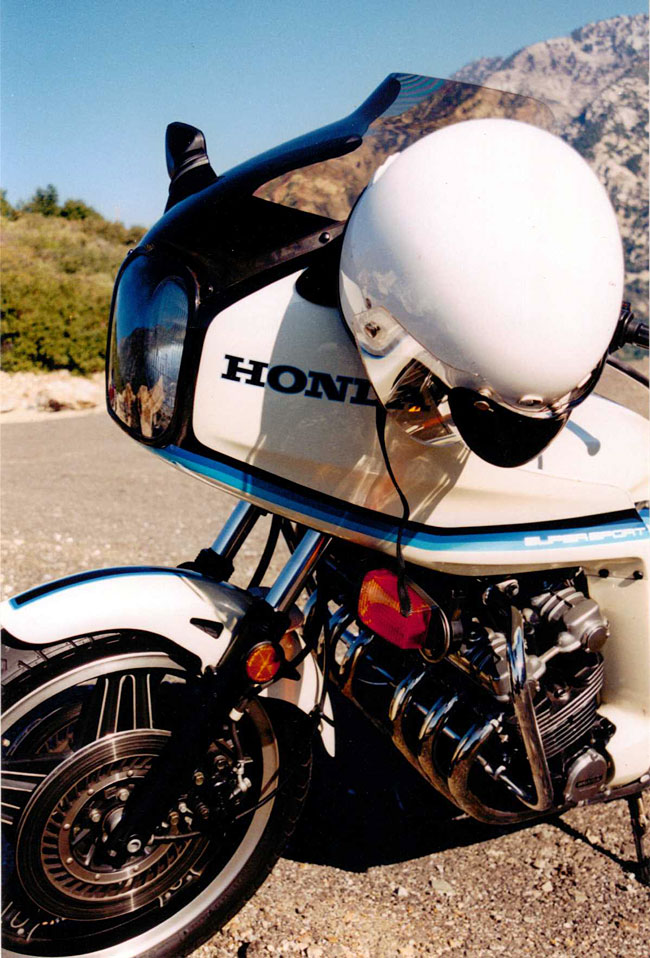I’d always wanted a CBX, ever since they were introduced by Honda in 1979. I bought a new Honda 750 Four when that bike first came out, and the CBX seemed a logical extension of the kind of engineering pioneered by the Honda 750. It was engineering excess raised to an exponent, the CBX was, I was a guy in my 20s, and in those days, dealers would let you take a bike out for a test ride. I’m the kind of guy that caused them to stop doing that. I lived in Fort Worth, the Honda dealer there gave me the keys to a new silver CBX with less than 20 miles on the odometer, and I tried to bury the needle on Loop 820 back in ’79. As I recall, I touched something north of 140 miles per hour, and when I returned to the dealer and put the bike on its sidestand, the cam covers were ejaculating oil. The bike’s honey-colored lifeblood was squirting out in an almost arterial fashion.
“What do you think?” the sales guy asked, hoping for a quick sale.
“It’s not for me,” I answered. “I mean, look at the thing…it leaks oil worse than my Harley.”
Still, I wanted a CBX. Always did, and in ’92, I finally scratched that itch.

I bought the CBX you see above in 1992 (when it was already 10 years old), but the bike only had 4500 miles on it and it was in pristine condition. The price was $4500, perfectly matching the odometer mileage. Everything was stock, and everything was in perfect shape (other than the tires, which were cracking with age).
I must have gone back to Bert’s dealership in Azusa four times drooling over that bike, and when I finally made up my mind to buy it and went back for a fifth time, it was gone. I’d lost my opportunity. Ah, well, I could bounce around for a while longer on my Harley. It was a different Harley than the one I mentioned above. That earlier one was a ’79 Electra-Glide and I called it my optical illusion because it looked like a motorcycle. The Harley I owned when I bought the ’82 CBX was a ’92 Softail, but that one was a real motorcycle. You could ride it without things breaking.
Bert’s was a magnet to me, and lots of times after work I’d stop there just to look at the motorcycles. The place was like an art gallery. I just enjoyed being there and taking it all in. Motorcycles can be art, you know. That bit of art that I had fallen in love with, the pearlescent white ’82 CBX, was gone. I had let it escape.
So, you can imagine my surprise a month or two later when I stopped in again and the CBX was back on the floor. The bike had been sold to a Japanese collector, I was told, and the deal fell through. Opportunity didn’t need to knock twice. I bought the CBX on the spot.
The CBX was an amazing motorcycle. 1050cc. Six cylinders. Six carbs. 24 valves. Double overhead cams. Actually, it was quadruple overhead cams. The cylinder head was so long each cam was split in two, and the two halves were joined in the middle of their vast reach across those six cylinders by what engineers call Oldham couplers. I didn’t know exactly what an Oldham coupler was or how it worked, but it sounded cool. I owned a motorcycle with Oldham couplers. How many people can say that?
The CBX didn’t have much bottom end, but once the engine got going, the thing was amazing. And the sound! Wow! It sounded like a Formula 1 race car. I read somewhere that the Japanese engineers actually spent time on a US aircraft carrier listening to fighter jets take off, and their objective was to make the CBX sound like that. When conditions were right, I convinced myself I could hear the F-14 in my CBX. Top Gun. Maverick. That was me.
The CBX was fun, and it drew looks wherever I rode it. Honda only made the CBX for 4 years (1979 through 1982). They were expensive to manufacture (it seemed like every fastener on the thing was a custom design) and they didn’t sell all that well. But it was an awesome display of technology. I’m a mechanical engineer, and the design spoke to me.
I never had any regrets with that old CBX. I rode it hard for the next 10 years, and other than dropping it a couple of times in 0-mph mishaps, it served me well. I rode it all over the Southwest and it never missed a beat. When I first bought it, I could walk into any Honda dealer and buy new parts (even though it was 10 years old). Ten years later (when the bike was 20 years old) that was no longer the case, and that scared me. The CBX was years ahead of its time and it was complicated. If something broke and I couldn’t find parts, I’d have a $4500 paperweight.
In those days, I was on a CBX Internet mailing list. I put a note on the list advising folks that I wanted to sell the bike and it sold that day. I got a fair price for it, and the mighty Six was gone. I have no regrets, folks…I had lots of fun and it was time to move on. But I miss that bike. It was fun, it was fast, it was different, and it was everything a motorcycle should be.
